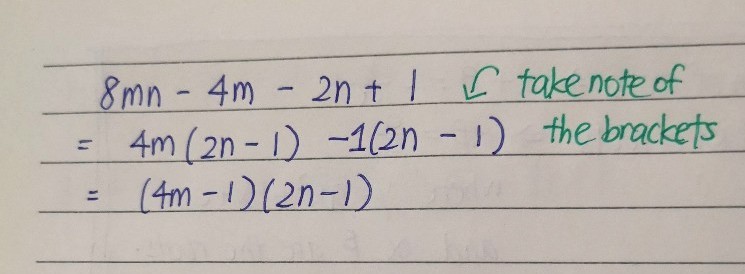Koh Su En's answer to SlyFox's Secondary 1 Maths Singapore question.
done
{{ upvoteCount }} Upvotes
clear
{{ downvoteCount * -1 }} Downvotes
Hi! Generally this is quite a short answer, I think the general question you have is why is it being done this way.
Usually factorisation, especially for equations that have 2 variables (x&y, or in this case is m&n), don't require you to factorise the WHOLE equation. It takes practice to identify what can you group together and factorise.
In this case the question was very nice and put the 2 'm' side by side, so with the first 2 you know that you can factorise out 4m.
Then after you factorise out 4m, you will see that the equation is:
4m (2n - 1) - 2n + 1
Then from this you have to see how can you make the right side to become (2n - 1), which can be done so by factorising out -1, which makes the equation becomes:
4m (2n - 1) - 1 (2n - 1)
Once it reaches this stage, you just need to factorise out (2n - 1) to give you the final answer.
There is no confirmed technique to this kind of questions, usually involve a bit of trial and error. And if you get it, then good but if you don't, in exam it's recommended to just move on.
General rule of thumb is to write those of the SAME VARIABLE side by side (Aka write all the 'm's together and 'n's together), then see how to factorise the other side.
Please note that you can get the same answer if you try to start the question by grouping 8mn - 2n together, and factorising out 2n first!! Do give it a try :)
Hope this helps!!
Usually factorisation, especially for equations that have 2 variables (x&y, or in this case is m&n), don't require you to factorise the WHOLE equation. It takes practice to identify what can you group together and factorise.
In this case the question was very nice and put the 2 'm' side by side, so with the first 2 you know that you can factorise out 4m.
Then after you factorise out 4m, you will see that the equation is:
4m (2n - 1) - 2n + 1
Then from this you have to see how can you make the right side to become (2n - 1), which can be done so by factorising out -1, which makes the equation becomes:
4m (2n - 1) - 1 (2n - 1)
Once it reaches this stage, you just need to factorise out (2n - 1) to give you the final answer.
There is no confirmed technique to this kind of questions, usually involve a bit of trial and error. And if you get it, then good but if you don't, in exam it's recommended to just move on.
General rule of thumb is to write those of the SAME VARIABLE side by side (Aka write all the 'm's together and 'n's together), then see how to factorise the other side.
Please note that you can get the same answer if you try to start the question by grouping 8mn - 2n together, and factorising out 2n first!! Do give it a try :)
Hope this helps!!
Date Posted:
4 years ago

